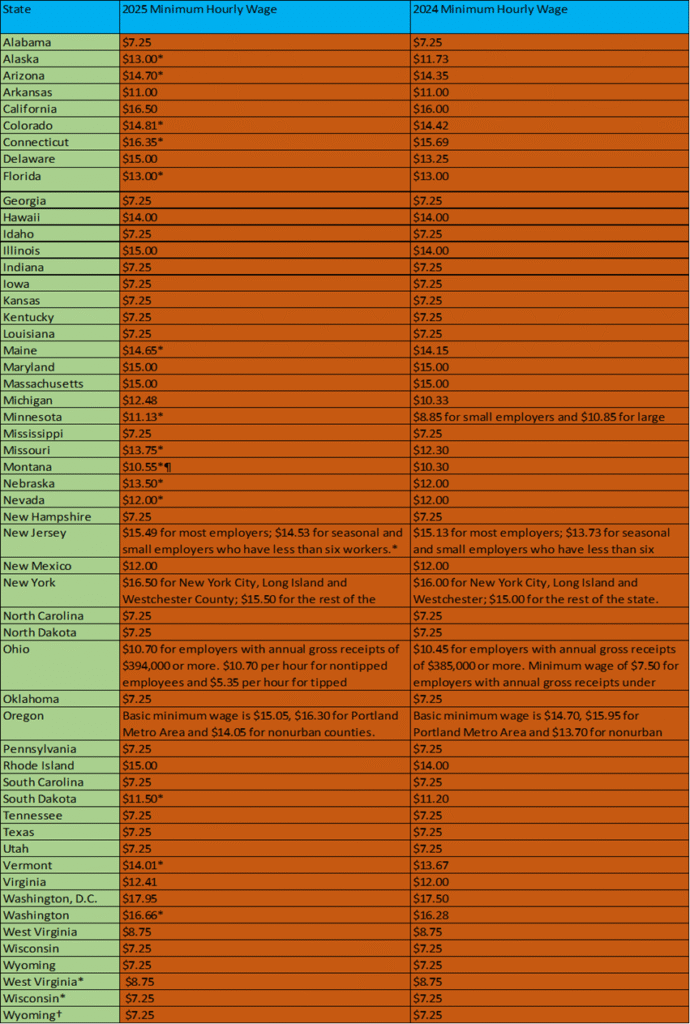USA Minimum Wage Hike 2025: Hello Americans!!!! Are you guys ready to witness the minimum wage increase? Here it is. This New Year has brought financial stability for many Americans. From the 1st of January, 2025, the minimum wage has increased in over 20 states, or, accurately, 22 states. From New York to California, the hourly wages have increased. The minimum federal wage is $7.25 per hour in the US. The basis of the rise in the cost of living and inflation forced households to limit their budgets.
To cope with the speed of inflation, the rising cost of minimum wage has considerably increased as a booster. The price has increased in 22 states likewise. In Washington, D.C., the minimum wage is now $17.95 per hour, which is the highest rise. States like New York and California have increased the minimum wage up to $15.50 and $16.50, respectively. The minimum wages in Oregon and Alaska have risen in July. These changes in wages have impacted more than 9 million employees.
The wage hike is meant for the betterment of the workers, as it is meant to provide a better financial situation in the midst of rising living costs. Minimum wage laws are not simple at all, but they change every year.

Reason behind the USA Minimum Wage Hike 2025:
The reason behind the wage increment is nothing but the efforts made by workers, voters, and lawmakers who believe pay should keep up with the rising cost of living. The basic amenities like food, house rent, petrol, medicine, and LPG get expensive when inflation hits. So as per the rule, if the cost of living rises, the wage will also rise to cope with or match the gap. Several states use the Consumer Price Index as a deciding factor in increasing wages as per a rise in inflation.
The states like Connecticut and New Jersey have already planned to slowly raise the minimum wage to a $15 per hour basis. As per the requirement, where there is a high cost of living, the raise will also be high. The basic federal minimum wage is $7.25 per hour, and it has remained the same since 2009.
How did the USA minimum wage get increased?
The increased wages apply to and are enjoyed by both part-time and full-time employees, and they are covered by the Fair Labour Standards Act or comparable local laws. The individuals who get the SSI benefits and SSDI benefits, along with the federal contractors who are coming under Order 13658 and the employees of local governments, will be paid at least $13.30 per hour.
The federal employees decided to get a minimum of $17.75 per hour from January 1, 2025, as directed by the order passed by President Biden. But on March 14, the order was revoked. This caused a massive setback for many federal contractors. And on March 14, when President Biden executed the order that caused the raise to $17.75 per hour, a major policy change happened.
Highlighted Changes in Certain States along with Midyear Revision:
In some locations, like in Oregon and Alaska, the minimum wage got increased in the middle of the year; it got increased in July 2025. Oregon’s minimum wage was increased to $15.05 within the state and $16.30 within metro Portland. Likewise, Washington, D.C., has raised its minimum wage to $17.95. Alaska has raised its minimum wage from $11.91 to $13.00. This has created an annual earnings increase of about $2267 for the workers who work full-time. There is an image attached below where you can find the comparison.
Who Gets Benefits of Wage Increase??
Now the question is, due to the wage hike, who got the benefit? The wage increase helped the part-time as well as full-time workers who are working in the retail, food service, and healthcare industries. As per the federal labour data, the Black workers, along with the South American workers who are in low-wage jobs, benefit from the wage hike. The full-time workers benefit from nearly $4,000 annually as a result of the hike from $13 to $15.
Drawbacks and repercussions of wage hikes:
Some critics have given the verdict that the raising of the minimum wage might cause job loss or higher prices or that many businesses will use machines as a replacement for employees. There are many industries that are running their business on a marginal budget, and now, due to the hike, they are going to pay their workers an extra wage, and this thing has created tension among industries like the hotel or restaurant business or any small business.
The research from groups like the Congressional Budget Office and different states shows mixed results. Most studies say that slowly and steadily raising wages usually doesn’t cause big job losses, and it can even help the local economy by giving workers more money to spend. Everything is contradictory on several fronts.
In upcoming years, many states will look to again raise their minimum wages as the cost of living increases every year. As we can see, there have been no changes in the federal minimum wage over the past 15 years. The minimum wage increase has created a balance, yet it considers situations for both the workers and the employer. As someone is getting the hike and someone is paying for the hike.
On the other side, if we see the perspective of the government, then it is questionable that in the future the federal minimum wage can get a chance of an increase to match the economy of recent years. A small and constant wage hike doesn’t ever hamper an economy. And along with this, nobody can handle the pressure of performance. So if you need the balance, choose the percentage of hike.

| cmcollegebounsi |
